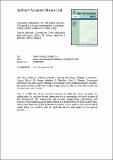Files in this item
Seamount influences on mid-water shrimps (Decapoda) and Gnathophausiids (Lophogastridea) of the South-West Indian ridge
Item metadata
| dc.contributor.author | Letessier, Tom B. | |
| dc.contributor.author | De Grave, Sammy | |
| dc.contributor.author | Boersch-Supan, Philipp H. | |
| dc.contributor.author | Kemp, Kirsty M. | |
| dc.contributor.author | Brierley, Andrew S. | |
| dc.contributor.author | Rogers, Alex D. | |
| dc.date.accessioned | 2016-11-28T00:33:14Z | |
| dc.date.available | 2016-11-28T00:33:14Z | |
| dc.date.issued | 2017-02 | |
| dc.identifier | 191125146 | |
| dc.identifier | 66284879-944a-4a8e-9353-4fea5049aa82 | |
| dc.identifier | 84930369888 | |
| dc.identifier | 000395228700007 | |
| dc.identifier.citation | Letessier , T B , De Grave , S , Boersch-Supan , P H , Kemp , K M , Brierley , A S & Rogers , A D 2017 , ' Seamount influences on mid-water shrimps (Decapoda) and Gnathophausiids (Lophogastridea) of the South-West Indian ridge ' , Deep Sea Research Part II: Topical Studies in Oceanography , vol. 136 , pp. 85-97 . https://doi.org/10.1016/j.dsr2.2015.05.009 | en |
| dc.identifier.issn | 0967-0645 | |
| dc.identifier.other | RIS: urn:2EA6F107D5E1544FDA48813951944A1D | |
| dc.identifier.other | ORCID: /0000-0002-6438-6892/work/60427314 | |
| dc.identifier.uri | https://hdl.handle.net/10023/9882 | |
| dc.description | This study was conducted under the UNDP/IUCN project, funded by the Global Environment Facility (GEF). The authors thank the School of Biology at the University of St Andrews and the National Environmental Research Council (NERC) for funding toward Tom B Letessier's PhD. | en |
| dc.description.abstract | Maintenance of often-observed elevated levels of pelagic diversity and biomass on seamounts, that are of relevance to conservation and fishery management, involves complex interactions between physical and biological variables that remain poorly understood. To untangle these biophysical processes we explore factors influencing the distribution of epi- and meso-pelagic (0–1000 m) micronektonic crustaceans (>15 mm; order Lophogastridea, family Gnathophausiidea; and order Decapoda) on and off seamounts along the South West Indian Ridge (SWIR, 27° to 42°S) and on a seamount off the Madagascar Ridge (31.6°S, 42.8°E). Thirty-one species of micronektic crustaceans were caught using mid-water trawls within the study are but there was no apparent latitude-related patterns in species richness or abundance. Species richness predicted by rarefraction curves and numerical abundance was highest in the vicinity (<1 km) of seamounts (species richness: 15 to 21; abundance: 10±2 to 20±1 ind.10−3 m−1) compared with over the abyssal plains and ridge slopes (species richness: 9.2–9.9; abundance: 24±2 to 79±8 ind.10−3 m−1). Multivariate analysis of assemblage composition revealed significant groupings of individual net samples with respect to whether the sample was on or off a seamount and hydrographic region, but not with time of sampling relative to diel cycle (day/night or dawn) or depth of sampling (0–500, 500-800,>800 m). The dominant species assemblage comprised the shrimps Systellaspis debilis (37%) and Sergia prehensilis (34%), and was restricted to seamounts on the subtropical SWIR. Our observations suggest that the ‘oasis effect’ of seamounts conventionally associated with higher trophic levels is also applicable to pelagic micronektic crustaceans at lower trophic levels. We suggest that the enhanced biomass and species richness attributed is due to ‘habitat enrichment’, whereby seamounts provide favourable habitats for both pelagic and bentho-pelagic mid-water crustaceans. | |
| dc.format.extent | 13 | |
| dc.format.extent | 1628363 | |
| dc.language.iso | eng | |
| dc.relation.ispartof | Deep Sea Research Part II: Topical Studies in Oceanography | en |
| dc.subject | Conservation | en |
| dc.subject | Indian ocean | en |
| dc.subject | Decapod shrimp | en |
| dc.subject | Gnathophausia | en |
| dc.subject | Deep sea | en |
| dc.subject | QH301 Biology | en |
| dc.subject | QL Zoology | en |
| dc.subject | NDAS | en |
| dc.subject.lcc | QH301 | en |
| dc.subject.lcc | QL | en |
| dc.title | Seamount influences on mid-water shrimps (Decapoda) and Gnathophausiids (Lophogastridea) of the South-West Indian ridge | en |
| dc.type | Journal article | en |
| dc.contributor.institution | University of St Andrews. School of Biology | en |
| dc.contributor.institution | University of St Andrews. Marine Alliance for Science & Technology Scotland | en |
| dc.contributor.institution | University of St Andrews. Scottish Oceans Institute | en |
| dc.contributor.institution | University of St Andrews. Centre for Research into Ecological & Environmental Modelling | en |
| dc.contributor.institution | University of St Andrews. Pelagic Ecology Research Group | en |
| dc.identifier.doi | https://doi.org/10.1016/j.dsr2.2015.05.009 | |
| dc.description.status | Peer reviewed | en |
| dc.date.embargoedUntil | 2016-11-27 |
This item appears in the following Collection(s)
Items in the St Andrews Research Repository are protected by copyright, with all rights reserved, unless otherwise indicated.

